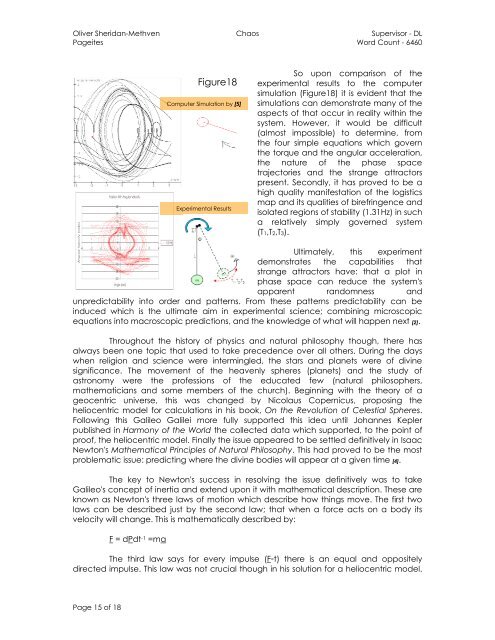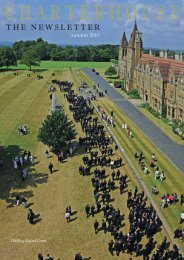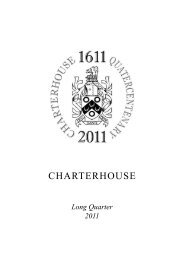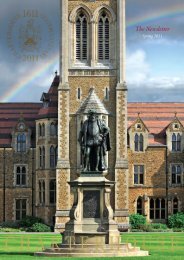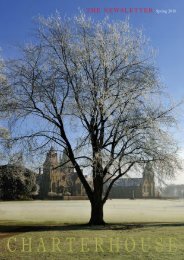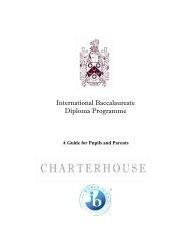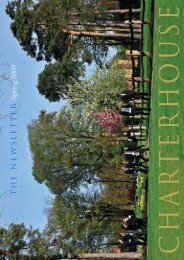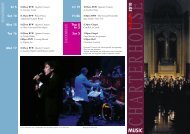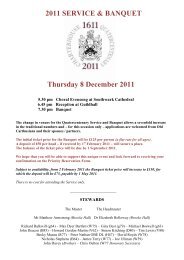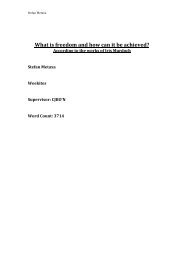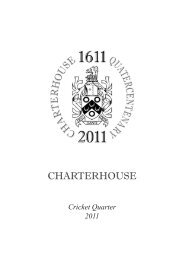Oliver Sheridan-Methven | PDF - Charterhouse
Oliver Sheridan-Methven | PDF - Charterhouse
Oliver Sheridan-Methven | PDF - Charterhouse
Create successful ePaper yourself
Turn your PDF publications into a flip-book with our unique Google optimized e-Paper software.
<strong>Oliver</strong> <strong>Sheridan</strong>-<strong>Methven</strong> Chaos Supervisor - DL<br />
Pageites Word Count - 6460<br />
Figure18<br />
Computer Simulation by [5]<br />
Experimental Results<br />
So upon comparison of the<br />
experimental results to the computer<br />
simulation (Figure18) it is evident that the<br />
simulations can demonstrate many of the<br />
aspects of that occur in reality within the<br />
system. However, it would be difficult<br />
(almost impossible) to determine, from<br />
the four simple equations which govern<br />
the torque and the angular acceleration,<br />
the nature of the phase space<br />
trajectories and the strange attractors<br />
present. Secondly, it has proved to be a<br />
high quality manifestation of the logistics<br />
map and its qualities of birefringence and<br />
isolated regions of stability (1.31Hz) in such<br />
a relatively simply governed system<br />
(T1,T2,T3).<br />
Ultimately, this experiment<br />
demonstrates the capabilities that<br />
strange attractors have: that a plot in<br />
phase space can reduce the system's<br />
apparent randomness and<br />
unpredictability into order and patterns. From these patterns predictability can be<br />
induced which is the ultimate aim in experimental science; combining microscopic<br />
equations into macroscopic predictions, and the knowledge of what will happen next [2].<br />
Throughout the history of physics and natural philosophy though, there has<br />
always been one topic that used to take precedence over all others. During the days<br />
when religion and science were intermingled, the stars and planets were of divine<br />
significance. The movement of the heavenly spheres (planets) and the study of<br />
astronomy were the professions of the educated few (natural philosophers,<br />
mathematicians and some members of the church). Beginning with the theory of a<br />
geocentric universe, this was changed by Nicolaus Copernicus, proposing the<br />
heliocentric model for calculations in his book, On the Revolution of Celestial Spheres.<br />
Following this Galileo Galilei more fully supported this idea until Johannes Kepler<br />
published in Harmony of the World the collected data which supported, to the point of<br />
proof, the heliocentric model. Finally the issue appeared to be settled definitively in Isaac<br />
Newton's Mathematical Principles of Natural Philosophy. This had proved to be the most<br />
problematic issue: predicting where the divine bodies will appear at a given time [4].<br />
The key to Newton's success in resolving the issue definitively was to take<br />
Galileo's concept of inertia and extend upon it with mathematical description. These are<br />
known as Newton's three laws of motion which describe how things move. The first two<br />
laws can be described just by the second law; that when a force acts on a body its<br />
velocity will change. This is mathematically described by:<br />
F = dPdt -1 =ma<br />
The third law says for every impulse (F◦t) there is an equal and oppositely<br />
directed impulse. This law was not crucial though in his solution for a heliocentric model.<br />
Page 15 of 18


